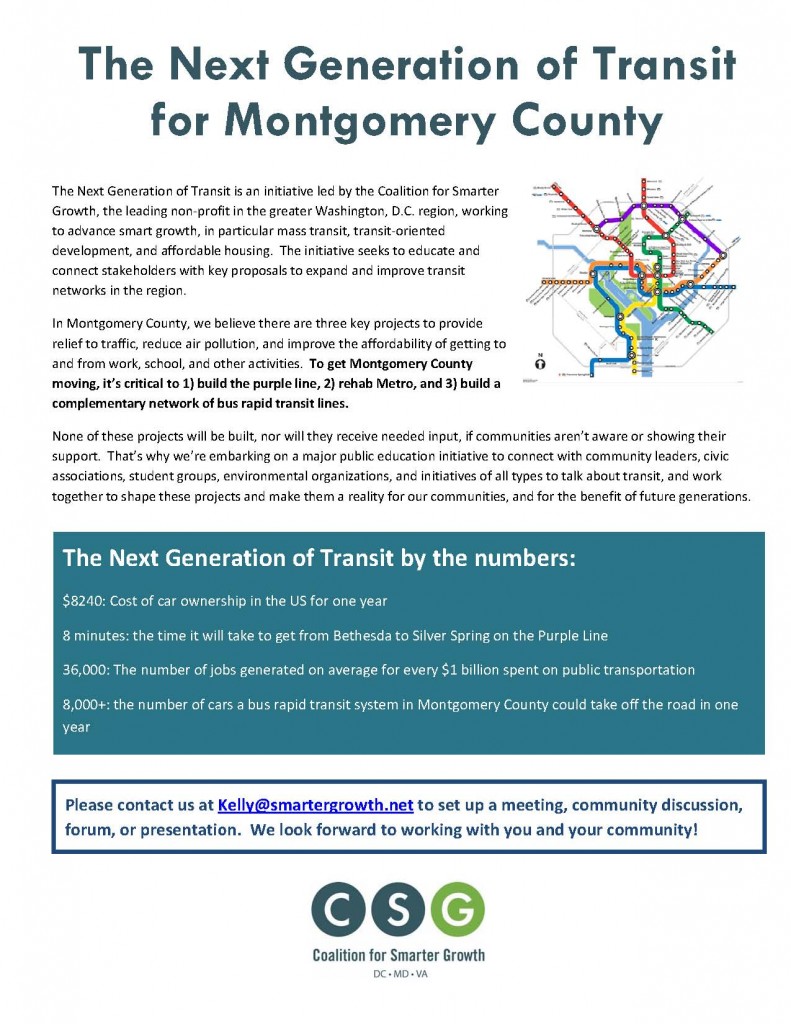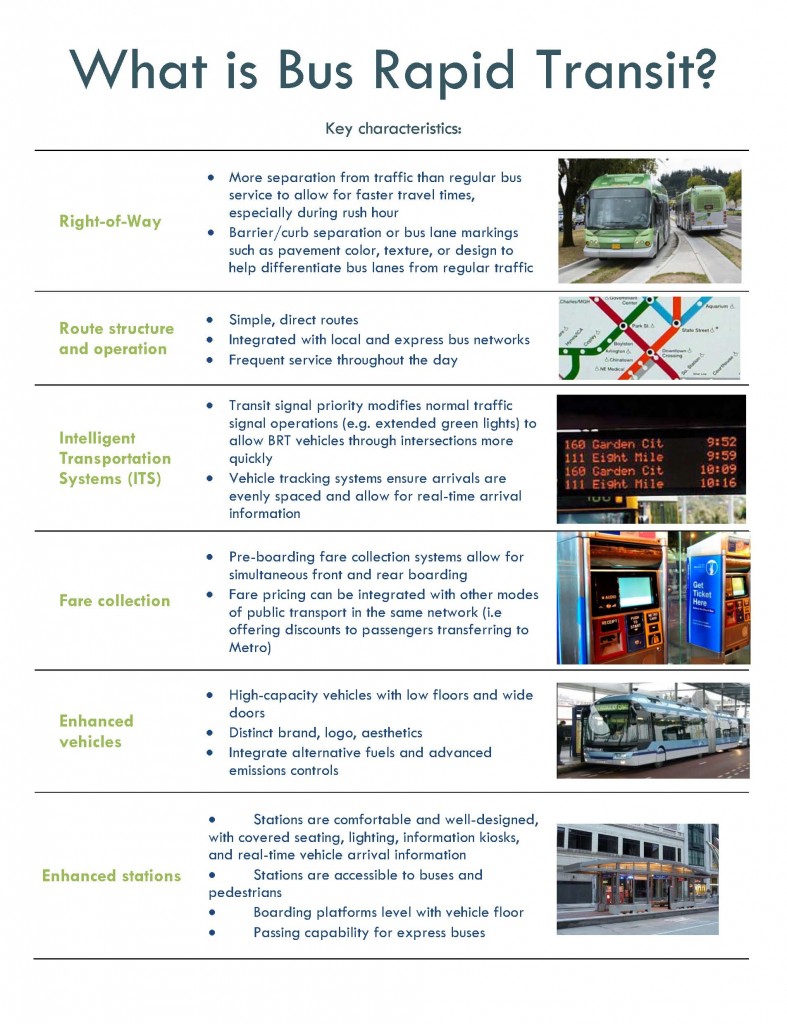Fifty years ago, visionary leaders conceived, planned, and built Metro, radically reshaping the Washington DC region. Today Metrorail is a national example of how a well-planned transit system can help fuel economic growth by revitalizing communities and helping hundreds of thousands of people get where they’re going each day. But where’s the plan for the next generation?
Today, with a new report, Thinking Big, Planning Smart: A Primer for Greater Washington’s Next Generation of Transit, the Coalition for Smarter Growth wants to engage residents in a campaign to win a new transit vision and the funding to implement it.
Regional leaders have expressed strong support for transit-oriented development in their Region Forward vision and in recent state of the county addresses, but our regional transportation plans are dominated by a never-ending list of new highways and road expansion projects, with a few disconnected transit projects.
Just two weeks ago, the Virginia Department of Transporation (VDOT) added a number of new road projects to the regional plan, but not a single transit project. While the road projects march forward, transit projects are forced to beg for funding.
So, our report is both a call to action and a baseline resource. It offers the first compilation of the region’s many transit and transportation plans, briefly summarizes the many benefits of transit to the DC region, and features and compares the metrics for six major transit projects or systems that are under construction or reasonably far along in planning, including the Silver Line, Purple Line, DC Streetcar, Arlington Streetcar, Alexandria Bus Rapid Transit and Montgomery Rapid Transit System.
A CSG volunteer, John Peck, worked to create a base map of all of the current rail transit lines and the six systems featured in the report. We gained a respect for the GIS professionals!
While we are encouraged by the new transit systems being proposed, we are very concerned that the region has no plan to interconnect the systems nor to ensure operational coordination including common fare card use and real time information, not to mention who should operate each system. We also found that the studies for these systems don’t share a common set of performance measurements. So we owe it to University of California engineering student Haleemah Qureshi for creating the first comprehensive, comparative table of metrics derived from the technical reports for each of the featured transit systems.
How do we get there?
“Make no little plans. They have no magic to stir men’s blood and probably will not themselves be realized.” Daniel Burnham’s quote is perhaps overused, but nevertheless, we need a regional commitment to a new transit plan, the funding to support it, and a hardnosed commitment to implementing it.
We are recommending extensive public involvement and modern crowdsourcing. We believe that a joint committee of elected officials who serve on the WMATA and Council of Governments boards, should oversee the process and complete a plan within two years. WMATA staff, who have been leading the PlanIt Metro analyses and the development of the Momentum program, should provide the lead technical support, and be assisted by COG staff and local transportation and land use planners. Your thoughts on the process?
Finally, our report includes a recommended set of principles to justify and guide the development of a new transit vision. Do you agree? What might be missing?
Principles to guide a next generation of transit
High-capacity public transportation is the most important investment for supporting a sustainable region of livable, walkable centers, and neighborhoods.
Several factors make public transportation investments critical:
- High energy prices and the high cost of auto transportation
- Climate change
- Air and water pollution
- Failure of road expansion to effectively manage traffic, due to induced demand and related inefficient patterns of auto-dependent development
- The significant number of residents who cannot drive, cannot afford a car or do not own a car. This includes lower-income residents, the disabled, the young and elderly, and the growing sector of our population seeking to live in communities where they do not have to be dependent on a car.
- The benefit public transportation provides in supporting compact, efficient development, lowering per capita infrastructure costs and saving land.
Rehabilitating and improving our Metrorail system must be our first priority.
Major public transportation investments must be tied to good land use: well-designed, compact, mixed-use, mixed-income, walking and biking-friendly neighborhoods with interconnected local street networks – both transit-oriented development and traditional neighborhood development.
Supporting build-out at our existing Metro stations should be a priority, and together with mixed-use development at all stations, will ensure that our Metro trains have high ridership in both directions all day.
New high-capacity public transportation corridors must include the region’s commercial/retail corridors. Given the strong commitment to preserving the character of existing suburban neighborhoods, these commercial corridors offer the best opportunity to absorb regional growth while protecting suburban neighborhoods.
We should be flexible and not locked into one public transportation mode as the answer. We should ensure we match the public transportation mode, design and service plan to the land use densities and levels of service we are trying to achieve.
Public transportation planners should ensure that each public transportation study considers all modes and the necessary mixed-use, walkable, and transit-oriented urban design essential to maximizing ridership and the value of the public transportation investment. Safe and robust access to public transportation by promoting walking and bicycling and supportive local street networks must be a part of any public transportation and funding plan.
Continuing to debate the mode after a final vote by an elected board or council isn’t constructive. It delays and even harms the advancement of much needed public transportation investments.
We can be proud of our region’s success with transit and transit-oriented development. But without the commitment of the public and our elected officials, we’ll fail to make the investments in the next generation of transit that are necessary to support the demand for transit-oriented communities, to offer an alternative to sitting in traffic, and to fight climate change.
With this report and the engagement of CSG members and GGW readers, we aim to spark a new transit plan for the region. In the coming weeks, we’ll be speaking to local elected officials, the WMATA board, the Council of Governments, the Northern Virginia Transportation Commission, transportation and land use planners, and the public. Stay tuned.
UPDATE 3/5/13: CSG has launched a Next Generation of Transit feedback catalog, where we’ll be cataloging feedback, comments, ideas and suggestions. Keep the conversation going in the comments below, but we also encourage you to check out and contribute to the catalog.
Photos courtesy of CSG via Greater Greater Washington






